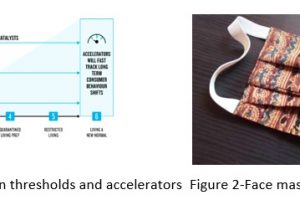As commonly discussed in a consumer behaviour class, learning is an ongoing & ever-changing process during which a consumer acquires knowledge and is applied in future. We all experienced a stringent lockdown in India for 68 days from 25-Mar-2020 to 31-May-2020 and subsequently ongoing lockdown for containment zones. So with the challenging time, it is quite uncertain to predict the consumer behaviour pattern for future once the pandemic challenge is over. But the change in habits will have a cascading effect on the consumer decision-making process and the buying behaviour of a consumer. This blog presents a brief review of changes in consumer behaviour during the challenging pandemic period and may be used for academic purposes by management students.
With the confinement set for over 68 days, each individual now first looks for the physiological needs and safety standards, a concept very well explained in the Maslow’s hierarchy of needs. How are brand changing? Amul [1] in the month of April-2020, launched Haldi milk as Haldi is known for its anti-bacterial and anti-inflammatory properties. Subsequently, in the month of June-2020, Amul launched Ginger and Tulsi milk [2] to boost immunity amid pandemic. Being in a social setup and in a society of collectivism, people in India look for ways to connect with others. For example, using the social network for digital sharing of photos and videos even by those who have never used the platform before this challenging pandemic phase. Nelson [3] identified the following six consumer thresholds (Figure 1), and each of them introduces a shift in consumer behaviour:
1. Proactive health-minded buying – to purchase preventative health and wellness products.
2. Reactive health management – to prioritise the purchase of essential protective gear like face masks, hand sanitisers, thermal scanning at the entry point. Social distancing and leveraging digital medium at work like online classes in schools and educational institutions, consultation from medical doctors, are some of the new normal. (See the video of our very own institute ISME adhering to the new norms).
Effect of Indian culture on face masks: Kalamkari face mask (customisable to the consumer) are now being sold which promotes culture of India and handloom products, thereby, kalamkari artisans are kept employed.
3. Pantry preparation – Stockpiling (e.g. tissue papers, groceries, household essentials) and pent-up demand are some of the key examples that can be notice during this phase of life. Consumers are forced to use a substitute product as a replacement and an alternative to their favourite brands.
4. Quarantined living preparation – experiencing out-of-stock in stores, making fewer store visits, increased online shopping leading to an increase in the frequency and use of digital payments (mobile payments, mobile banking, electronic banking). Due to the sudden scarcity of certain goods and services during this challenging pandemic situation, disruption in supply chain & distribution channels combined with surge in demand, even FMCG products in the neighbourhood “kirana stores” have empty shelves. Consumers and organisations are equally exploiting the potential of digital platforms to the fullest possible, be it watching movies, connecting with family and friends through social networking sites or companies moving to online platform from the traditional brick and mortar model.
5. Restricted living – making much fewer shopping trips, limited online fulfilment, no longer shared mobility, delaying purchases and in some cases abandoning their plans. We have witnessed the restricted number of people allowed inside a grocery shop to maintain social distancing. Retailers and restaurants may need to introduce new concepts keeping in mind the mandatory safety measures and increased wait time affecting consumer behavior. Innovative concepts in clubs like “social dis-dancing” [4], are being introduced to attract consumer and keep the business running while ensuring safety. Another example, advertisement by Cadbury “How Far Will You Go for Love” to connect today’s youth is an example of social distancing.
Worldwide brands are conveying optimism with a changed focused towards health and safety of their customer. A caring brand will be perceived as safe and improve brand equity in the minds of a consumer. As described by David Aaker, the creator of Aaker Brand Equity model, marketers assure their customers that the brand meets their safety expectations and setting a safety bar to be more relevant than their competitors. This could introduce a positive shift in consumer’s attitude towards the brand as consumers value emotions and are sensitive towards the safety needs.
6. A new normal – return to daily routines (work and education) but permanently altered supply chain, use of e-commerce and hygiene practices. For example, a shift in behavior to adopt and transition to digital payment was noticed during the demonetization period (Nov-2016) in India. This pandemic phase has further fuelled the adoption of digital payments wherein a consumer, being careful of health hazards, may no longer want to handle a physical currency note. In the education sector, the Government of India is making policy decision of conducting online classes in schools.
How will all this affect Brands and consumers? Digital has now become the new norm with brands changing their strategies and providing solutions accordingly. For example, Idea’s campaign promoting the power of 4G network “online seekho apnoke saath” [5]. Challenging times are ahead for marketers to decode sentiments on consumers, like Dominos offering ‘zero contact delivery’. Brands may need to adapt to new conditions as brand association and awareness may be forgotten by consumers. And some of these changes in consumer behaviour may as well be irreversible!
I hope this blog provides an insight to the students of marketing on consumer behaviour aspects in this state of influx.
Disclaimer: The views, opinions, and content on this blog are solely those of the authors. ISME does not take responsibility for the content which are plagiarized or not quoted.
References
[1]https://www.amul.com/products/Amul-Haldi-Doodh-Can-info.php
[3]https://www.nielsen.com/us/en/insights/article/2020/covid-19-tracking-the-impact-on-fmcg-and-retail/
[5] https://youtu.be/g2fa56wjZB0






